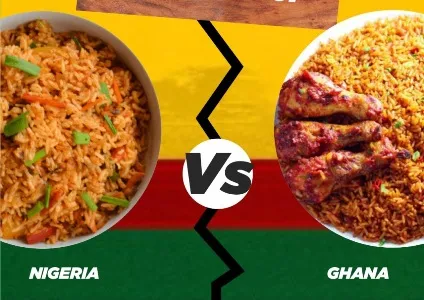From the vibrant streets of Accra to the bustling markets of Lagos, a single dish stirs passion and pride on both sides: jollof rice. This hearty and colorful West African dish has sparked countless debates, with Ghana and Nigeria both claiming to have the best recipe. What truly makes these dishes different, and which one reigns supreme? Let’s dive into the heart of this culinary battle to understand what makes each version shine.
A Quick Look at Jollof’s History and Origins
Jollof rice originated in the Senegambia region with the Wolof people, giving it a long-standing history that predates both Ghana and Nigeria. Initially prepared with fish and fresh vegetables, the dish spread across West Africa due to its simplicity, versatility, and delightful taste. Today, each country that adopted jollof rice has infused it with local spices, flavors, and techniques, making every recipe unique.
The Key Differences Between Ghanaian and Nigerian Jollof
Ingredients
Both Ghanaian and Nigerian jollof rice typically include similar base ingredients—rice, tomatoes, onions, and peppers. However, their choice of spices and extras sets them apart.
- Ghanaian Jollof: Known for using aromatic spices like cloves and nutmeg, Ghanaian jollof has a richer, earthier flavor. Ghanaians often cook their jollof with long-grain rice, adding vegetables and sometimes even meat into the pot for a balanced, savory dish.
- Nigerian Jollof: Nigerian jollof stands out for its use of a concentrated tomato and pepper base with the addition of thyme and curry powder. This mix gives it a bright, fiery color and bold, spicy flavor. Nigerian jollof is generally cooked with long-grain parboiled rice, which absorbs the spices without becoming too mushy.
READ ALSO
Cooking Techniques
Both countries take pride in the “party jollof” method, where jollof rice is cooked over high heat, allowing the bottom layer to brown and create a smoky, charred aroma.
- Ghanaian Jollof Method: Ghanaians start by frying their onions, peppers, and spices before adding the tomato sauce. Then, they add the rice and cook it slowly, allowing the flavors to infuse deeply into the grains. The result? A softer, deeply flavored jollof rice that captures the essence of the spices used.
- Nigerian Jollof Method: Nigerians are known to blend fresh tomatoes, bell peppers, and scotch bonnets into a smooth paste, which they then cook into a thick, spicy sauce. Nigerian jollof is famous for its “burnt bottom,” achieved by allowing the rice to cook until the bottom layer is slightly crispy, giving it that unique, smoky flavor.
Flavor Profiles: A Bite-by-Bite Comparison
- Ghanaian Jollof Flavor: Rich, spicy, and full-bodied, with subtle undertones of warm spices. Ghanaian jollof has a depth of flavor that comes from a slower cooking process and more seasoning.
- Nigerian Jollof Flavor: Bolder, hotter, and more intense, with a punch of tomato and pepper. Nigerian jollof has a kick that’s unmistakable, making it ideal for those who love a spicier dish.
Recipes: How to Make the Perfect Ghanaian and Nigerian Jollof at Home
Ghanaian Jollof Recipe

Check out full recipe at Green Views
Ingredients:
- 2 cups long-grain rice
- 2 cups tomato puree
- 1 large onion, chopped
- 1 tbsp ginger paste
- 1 tsp garlic paste
- 1 tsp curry powder
- 1 tsp thyme
- 1/2 tsp nutmeg
- Salt to taste
- 1/4 cup vegetable oil
- 3 cups chicken stock
Instructions:
- Heat oil in a large pot and sauté onions, ginger, and garlic until fragrant.
- Add the tomato puree, curry powder, thyme, and nutmeg. Simmer for 10 minutes.
- Pour in the chicken stock and season with salt.
- Add the rice, cover, and cook on low heat until the rice is tender and has absorbed the flavors.
- Let it sit for a few minutes before serving for optimal flavor.
Nigerian Jollof Recipe

Check out full recipe on Chef Lola’s Kitchen
Ingredients:
- 2 cups parboiled long-grain rice
- 4 tomatoes, blended1 large red bell pepper, blended
- 2 scotch bonnet peppers, blended
- 1 large onion, finely chopped
- 1 tbsp tomato paste1 tsp thyme
- 1 tsp curry powderSalt to taste
- 1/4 cup vegetable oil3 cups chicken stock
Instructions:
- Heat oil in a pot and sauté onions until golden brown.
- Add the blended tomato, bell pepper, and scotch bonnets.
- Add thyme, curry powder, and tomato paste.
- Cook until the sauce thickens.Pour in the chicken stock, then add rice.
- Cover and cook until the rice is soft and slightly smoky.
- Stir, let sit, and serve hot.
Cultural Significance of Jollof in Ghana and Nigeria
Jollof rice is more than just food in both countries; it’s an expression of culture, identity, and pride. Families have passed down recipes for generations, and many people believe the dish represents their heritage and culinary skills.
The Jollof Wars: How Social Media Keeps the Debate Alive
Every year, jollof fans take to social media, passionately defending their version of the dish. The “Jollof Wars” hashtag trends on Twitter, with supporters from each side claiming victory in taste tests, cooking competitions, and celebrity endorsements.
Tips for Making the Perfect Jollof Rice
- Choose the Right Rice: Long-grain parboiled rice is ideal for Nigerian jollof, while Ghanaian jollof often works best with regular long-grain rice.
- Cook Slowly: Patience is key. Letting the flavors simmer allows the rice to absorb the spices fully.
- Don’t Forget the Burnt Bottom: Both Ghanaian and Nigerian jollof enthusiasts agree that a slightly crispy bottom layer adds an authentic, smoky touch.
Why the Jollof Debate is Good for West African Cuisine
The spirited debate between Ghanaian and Nigerian jollof enthusiasts has elevated the dish to international fame, sparking curiosity about West African cuisine. Today, jollof rice is celebrated globally, and the “jollof wars” have become an ambassador for West African food, leading people from all over the world to try their hands at making the dish.
Which Jollof is Truly the Best?
The best jollof depends entirely on personal taste. If you prefer bold, spicy flavors, Nigerian jollof might win your heart. If you enjoy a more subtly seasoned, hearty dish, Ghanaian jollof could be your top choice. But no matter which side you choose, there’s no denying that both dishes showcase the creativity and passion of West African cuisine.
This battle of flavors has become a uniting force, sparking camaraderie and playful banter between Ghanaians and Nigerians. Try out these recipes, share your thoughts on social media, and join the jollof conversation. Whether you’re a Ghanaian jollof fan or a Nigerian jollof devotee, remember: every plate is a tribute to the love and artistry behind this iconic dish.




One thought on “Ghanaian Jollof vs. Nigerian Jollof: The Ultimate Taste Showdown”
Comments are closed.